CASE STUDY: Stress and Smoking
CASE STUDY: Stress and SmokingOverview
Overview
 For many people who smoke, the most natural thing to do in the midst of a stressful situation is to reach for a cigarette. Many smokers will explain that smoking helps them to relax and relieves their feeling of stress. Their adamant belief that this truly works has introduced the question of whether smoking does indeed relieved the amount of stress perceived by a smoker. The goal of this study was to investigate the relationship between smoking and the amount of recent life stress perceived, using some other variables such as age, and gender as independent (or explanatory) variables or covariates. Stress is a dependent response variable at three levels. Smoking can be viewed as either independent or independent categorical variable at three levels, and age (3 levels) and gender (2 levels) are independent variables (factors) as follows:
For many people who smoke, the most natural thing to do in the midst of a stressful situation is to reach for a cigarette. Many smokers will explain that smoking helps them to relax and relieves their feeling of stress. Their adamant belief that this truly works has introduced the question of whether smoking does indeed relieved the amount of stress perceived by a smoker. The goal of this study was to investigate the relationship between smoking and the amount of recent life stress perceived, using some other variables such as age, and gender as independent (or explanatory) variables or covariates. Stress is a dependent response variable at three levels. Smoking can be viewed as either independent or independent categorical variable at three levels, and age (3 levels) and gender (2 levels) are independent variables (factors) as follows:
Penn State researchers explored the relationship (if any) between four variables in the dataset, stress.txt:
- smoking status (1 = smoker, 2 = quitter, 3 = non-smoker) in column 1,
- gender (1 = male, 2 = female) in column 2,
- age (1 = young, 2 = middle, 3 = old) in column 3, and
- perceived stress level (1 = severe / a lot, 2 = moderate / some, 3 = mild / none) in column 4.
Stress is a "polytomous response" — having three values.
The data can be cross classified as a four-way table.
The relevant SAS programs and data for this case can be found below:
- stress.sas, and
- the dataset, stress.txt.
A couple of things to know about this study ...
A couple of things to know about this study ... Random Zeros
Random Zeros
What is the difference between a random zero and a fixed zero? This dataset includes a random zero. Does this impact the analysis of this data? How so? What can you do about this?
The Experimental Design
Does it make a difference how the data is collected? How does the experimental design impact the analysis of the data in this study? Is this something that you should report? How? Why?
In the context of the design of the study, both Age and Gender should be viewed as explanatory variables. The intent of the study was to obtain 50 males and 50 females in each of three age groups, for a total sample size of 300. For whatever reasons, this was not quite accomplished. There were 48 males and from each of the 3 age groups, and 51, 51 and 47 females in the three age groups, so that there were 144 males and 149 females, and 99, 99, and 95 people in the three age groups.
What kinds of questions can be asked?
Given this set of data, what questions could be asked by researchers? Who decides which questions are going to be the focus of the analysis? What if something else comes up that the researcher has not considered? What role should the statistician play? What responsibilities does the statistician have?
In this case study, with both Stress and Smoking treated as responses
- Is there an interaction between the responses Stress and Smoking?
- Does the explanatory variable (factor) Age affect the joint responses or does it affect one response but not the other, or does it affect neither response?
- Does the explanatory variable (factor) Gender affect the joint responses or does it affect one response but not the other, or does it affect neither response?
- Do the two factors interact to affect the responses?
When one of the two variables is a response (say Stress) and the other (say Smoking) is a ‘factor’
- Are there interaction effects—two-way or three-way--among Age, Gender, and Smoking on the response variable?
- Which factors among the three possible affect the response variable?
Exploratory Analysis
Exploratory AnalysisThe Statistical Models
Loglinear Models
What model is the following SAS program investigating? What question is this part of the program stress.sas asking?
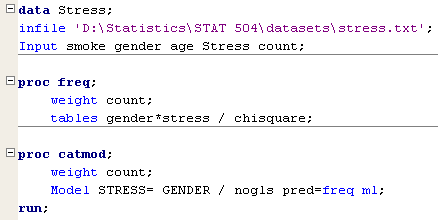
Probably more interesting is to see the effects of both gender and age on stress (later in the same program) ...
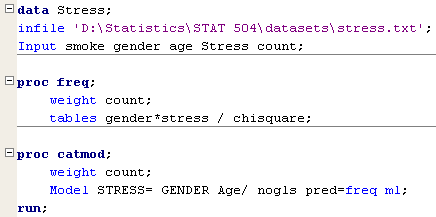
In the third type of model where you treat both stress and smoing as responses what happens? Does the problem get more complex? How so?
Polytomous Logisitic Regression Models
Why is this an example of a polytomous logisitic regression?
Could a loglinear model analysis apporach be taken with this data? What are the consequences of this type of an approach with this type of experiment? What happens?
A loglinear approach can be taken for a couple of reasons: (a) to identify possible associations among variables to assist in finding appropriate polytomous models and (b) to illustrate differences between treating variables as responses and factors.
Sample SAS programs (2 responses and 4 responses)
(Again, see the SAS program stress.sas.)
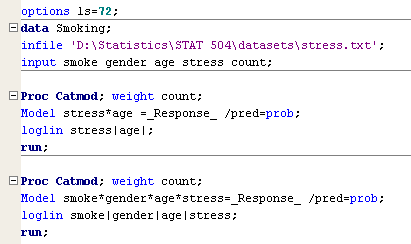
Polytomous Logistic Regression Models with One Response
- Stress on Gender (simplest polytomous model)
- Stress on Smoking, Age, and Gender
- Smoking on Gender
- Smoking on Stress, Age, and Gender
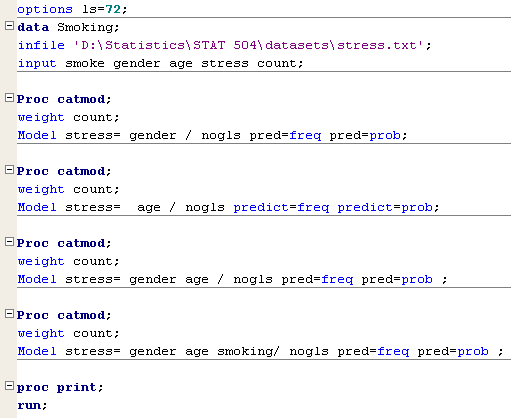
Polytomous Logistic Regression Models with Two Responses
- Stress and Smoking on Gender
- Stress and Smoking on Age
- Stress and Smoking on Gender and Age
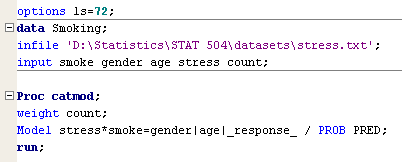
How complex can the models get? What are parameter estimates?
How complex can the models get? What are parameter estimates?A Loglinear Approach and Complex Studies
About Parameter Estimates...
What are parameter estimates and how do they aid the analysis of your data?